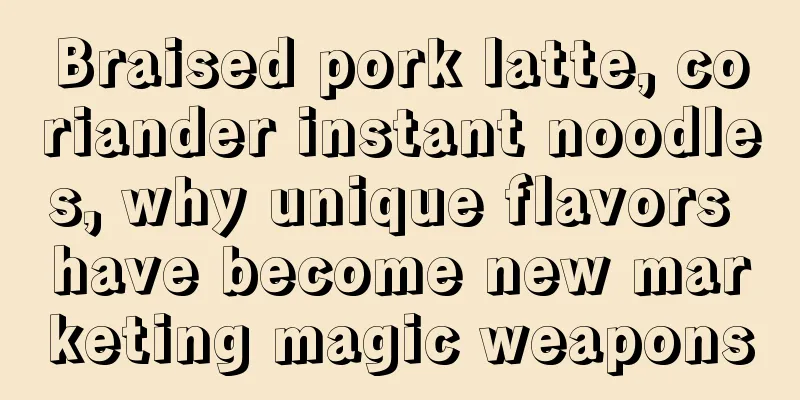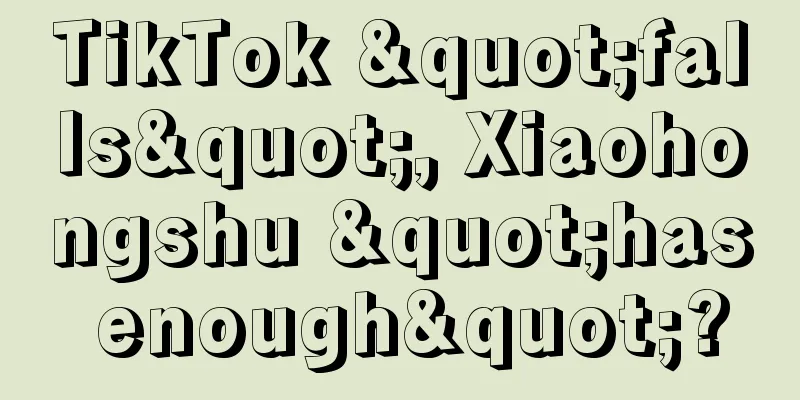Braised pork latte, coriander instant noodles, why unique flavors have become new marketing magic weapons

In the food and beverage market, a new trend seems to be quietly emerging, pushing the word "strange" to unprecedented heights. Recently, Pizza Hut launched coriander and preserved egg beef pizza and coriander and lemon sparkling drinks, which silenced both those who eat coriander and those who don't. This is also the second time that Pizza Hut has wildly explored the boundaries of strange flavors after last year's coriander and red oil pig ear pizza. This is not an isolated case. Around the Spring Festival this year, Starbucks launched a braised pork flavored latte, which sold for 68 yuan a cup. This new product immediately sparked heated discussions among consumers, and sales were reportedly good. In today's information explosion, people are surrounded by all kinds of products. Traditional, conventional flavors seem to be unable to satisfy their desire to explore the unknown. These weird-flavored foods and beverages have become a new choice for consumers pursuing novel products, providing consumers with a new sensory experience that makes them feel surprised and excited. In fact, this trend did not emerge today. 1. Peculiar flavors, from occasional occurrences to routine operationsA few years ago, in order to promote the cherry blossom season in Japan, Starbucks launched a special Sakura Latte. This drink is inspired by cherry blossoms, the cup is eye-catching in color, and cherry blossom flavor is added, becoming a romantic symbol limited to spring. Coca-Cola Plus Coffee is another example, combining the rich taste of coffee with the freshness of cola to provide a new taste experience. The product was first launched in the Australian and Vietnamese markets in 2017 and has since been gradually expanded to other countries. Pumpkin spice flavored Oreo is a product launched by the brand for Halloween. Its unique pumpkin spice flavor has attracted a large number of consumers to try it. The Lays brand is no exception. They have launched the Laotan Pickled Cabbage and Fish Flavored Potato Chips. This product incorporates the flavors of Chinese dishes into potato chips, bringing consumers the eating experience of Chinese potato chips. In the era of social media, more and more bloggers are trying to make their own products with special flavors in order to attract traffic. For example, someone once made Lao Gan Ma ice cream and shared it online. This unique combination of a famous chili sauce brand and traditional ice cream quickly attracted a lot of attention and discussion. Many people even began to follow suit and make their own versions, sharing the production process and tasting experience. As the fast-moving consumer goods market becomes increasingly inward-looking, some brands have seen the potential of such novel products on the one hand, and on the other hand, in order to create hype, continue to attract consumers, and increase brand exposure, they have begun to adopt this method in large numbers to launch new products. In 2020, Hema Fresh launched milk duck blood. The launch of this product can be said to be quite unexpected. Originally, Hema’s procurement team just wanted to find a product in retail that could rival the fresh duck blood in traditional hot pot restaurants, but it was difficult to achieve due to food safety considerations. However, by chance, they discovered this duck blood containing milk, which was almost unpopular in the market at that time. After trying it, they found that its taste and quality were good. As a result, once the milk duck blood was launched, it quickly became the single product sales champion in Hema Hotpot, showing the huge market potential of novel products. In 2023, Baiyang launched coriander noodles on Douyin. As a popular product on social media platforms such as Douyin, coriander noodles quickly captured the curiosity of a large number of consumers with its unique taste and positioning, becoming an Internet celebrity product of the year. The taste of this product is not to mention, the controversy brought by coriander has successfully aroused discussion and achieved a significant increase in sales. The pepper flavored Wanglaoji launched by Wanglaoji is also an example. It combines traditional herbal tea with the flavor of pepper, and has attracted widespread attention and discussion since its launch. This product not only refreshed people's perception of the traditional flavor of herbal tea, but also brought significant exposure to Wanglaoji. It has gradually become a trend to launch products with strange flavors. For example, ginger-flavored carbonated drinks, garlic coffee, and aged vinegar cola are constantly being launched. More and more people are beginning to share strange foods on social networks such as Xiaohongshu, Weibo, and Douyin. 2. Why are there more and more strange flavors?Why are there more and more foods and beverages with strange flavors? This has something to do with the current market environment and consumers' mentality. 1. Product innovation is weak, and unconventional approaches attract attentionIn today's fast-moving consumer goods market, there are more and more brands, and new and old consumption are constantly competing with each other. Every brand wants to do something to win the attention of consumers. For brands, the best option is of course product innovation, but the traditional product innovation path is becoming increasingly difficult. The cost of developing new products is high and the risks are huge, while the number of new products that can truly arouse widespread attention and discussion in the market is limited. Therefore, brands began to look for new innovation directions, and launching products with strange flavors became an effective strategy. By creating a strange and controversial product at a low cost, it can quickly trigger heated discussions on social media and become the center of discussion, thereby effectively improving brand visibility and consumer interest. Therefore, under the dual pressures of weak product innovation and fierce market competition, brands have taken a different approach and launched products with unique flavors to attract attention and promote sales, which has become a common and effective marketing strategy. 2. Subcultures are on the rise, and even the smallest hobbies have a marketIn a huge market like China with a population of 1.4 billion, any sub-category is likely to find its potential consumer group. This is in stark contrast to many other countries. For example, a brand focusing on the specific delicacy of river snails rice noodle may only attract a few million potential consumers in France, while in China, this number can easily reach tens of millions. This difference in market capacity allows even the most niche and peculiar products to have the opportunity to succeed and be recognized, bringing unexpected market share to the brand. At the same time, the rise of subcultures has further deepened this phenomenon . With the popularization of the Internet and the development of social media, more and more niche cultures and groups with specific interests have begun to receive attention. Although these subculture groups account for a small proportion of the entire market, their uniqueness and high group cohesion make them a force that brands cannot ignore. This is particularly evident in the Chinese market, where various consumer groups with niche interests and special preferences are likely to become loyal fans of a certain product. Therefore, foods like douzhi will have a very large audience and amount of discussion. Seeing this, brands began to actively launch products with unique flavors that meet the preferences of these niches. These products may seem strange at first glance, but it is their unique characteristics, combined with national marketing channels and cross-regional communication capabilities in the Internet era, that have made these originally niche products gain great attention. This not only opens up new markets for brands, but also allows these niche preferences to be exposed on a broader platform, gaining unexpected market returns. 3. Consumers need new dopamineConsumers all have a curiosity mentality, and dopamine is actually at work behind this. Dopamine is not a "reward", but a "driving factor". That is, when a person expects or seeks a reward, the brain releases dopamine, and when a person actually gets a reward, the dopamine level may drop or remain the same. Dopamine is released due to expectations for the future. Once expectations are exceeded, we will get extra rewards. This is also the reason why merchants try every means to launch various new products and consumers like to buy new products. Drinking a bottle of Coke, a cup of coffee, or eating a popsicle, there is nothing worth looking forward to or being surprised about. But if it is cherry-flavored Coke, coconut-flavored coffee, or durian-flavored popsicle, would you be immediately interested? Dopamine will drive you to try these new things, and we get more pleasure from the anticipation simply because of these fresh combinations. The brain will set an expectation level for these new products, and the more it exceeds expectations, the happier it feels. Wanglaoji with Sichuan pepper flavor and coriander instant noodles, these are things you have never heard of or seen before. Once they come into your sight, you will become interested. Dopamine will drive you to try these new products and get a new experience. Of course, once you try them, your dopamine level will drop, and you will no longer look forward to it. This is why the sauce-flavored lattes launched by Luckin Coffee and Moutai sold well in the early stages, but now almost no one cares about them. 4. Create emotional connections and memoriesToday, consumers' expectations for purchasing brands have gone far beyond simple satisfaction of needs. They desire a sense of ritual and emotional resonance with the product. Especially during different festivals and special moments, consumers tend to look for unique products that can evoke specific emotions or memories, which not only meets their need for a sense of ritual, but also enhances their sense of identity with the brand. By launching products that are closely linked to consumers’ personal experiences, cultural festivals or popular trends, brands can effectively deepen consumers’ emotional connection with their products. For example, limited-edition products launched for cultural festivals such as the Spring Festival and Christmas are not only full of festive characteristics, but also can trigger consumers' festive emotions and memories, thereby increasing consumers' willingness to buy and brand loyalty. For example, Starbucks' Sakura Latte launched during the cherry blossom season played this role. Cross-border cooperation that follows popular trends is also an effective strategy to enhance consumers’ emotional connection. By cooperating with other fields such as animation and art, brands can launch innovative and topical co-branded products, which can not only attract consumers’ attention, but also make consumers feel that the brand keeps up with the trend, is trendy and interesting. For example, Luckin Coffee often cooperates with popular IPs to launch cross-border products. For example, when snail noodle was the hottest, launching a snail noodle flavored ice cream was a move that was in line with the trend. These can effectively capture the interest of consumers, allowing consumers to enjoy the product while also feeling the brand's innovation and fashion. This connection based on emotion and memory can remain in consumers' minds longer than simple product features or price advantages, and becomes an important force driving long-term consumer loyalty and word-of-mouth communication. 5. Use hunger marketing to boost sales of conventional productsBrands launching exotic flavors are generally not a long-term strategy, but more of a short-term marketing tool. The essence of this practice is to use marketing gimmicks to attract public attention, thereby indirectly promoting sales of the brand's regular products. By launching limited-edition products with unique flavors, brands can successfully launch hunger marketing, which not only creates huge traffic and public discussion, but also stimulates consumers' desire to buy. Even those consumers who ultimately fail to purchase limited-edition products may turn their attention to and purchase the brand's regular products. Another significant advantage of this strategy is attracting new customers. Many consumers may be first exposed to brands because of their curiosity about exotic flavors, which provides a valuable opportunity for brands to showcase their wider product lines to these potential new customers. Once these new customers are interested in the brand, even if it is because of a short-term exotic product, they may become long-term loyal customers. For example, when Luckin Coffee and Moutai’s soy sauce latte became popular in the market, its rapid sale not only increased its appeal to consumers in a short period of time, but also brought in many new customers. More importantly, this short-term market boom also promoted the exposure and sales of other brand products. Even those consumers who failed to try the limited-edition drinks may have developed a favorable impression of the brand and then explored and purchased other products of the brand. 6. Build social identity and a sense of belongingBrands launching products with unique flavors often attract huge attention and discussion, which is actually a kind of social currency. In this process, consumers who successfully purchase these products gain a new social identity and sense of belonging, and their successful "hunting" becomes a capital for showing off and sharing. This phenomenon largely reflects the psychological game between consumers. Consumers who own these limited edition or unique flavor products tend to share their "trophies" on social media to show their taste and uniqueness, thereby gaining recognition and envy from friends and online communities. This not only enhances their social identity, but also deepens their loyalty and goodwill towards the brand. Those who fail to purchase these products may feel envious and jealous, which in turn stimulates their stronger curiosity and desire to buy the products. In addition, as a kind of social currency, the value of unique products lies not only in the products themselves, but also in the fact that they can provide consumers with a pass to join a specific community. To a certain extent, these products have become a symbol that distinguishes the identities and tastes between different consumer groups and provides consumers with a sense of belonging and identity. This social identity and sense of belonging obtained through products makes consumers more actively participate in the brand's marketing activities, which not only creates traffic and discussion for the brand, but also deepens the emotional connection between the brand and consumers. 3. ConclusionWith the intensification of market competition and the diversification of consumer demands, food and beverages with unique flavors have gradually become the mainstream of marketing, becoming an important strategy for brands to attract consumers' attention, create topics and increase sales. First, faced with the internal competition and innovation challenges in the fast-moving consumer goods market, brands have taken a different approach by launching products with unique flavors to attract public attention. At the same time, they have used strategies such as limited sales to create the effect of hunger marketing, which has not only generated traffic but also promoted the sales of conventional products, thereby achieving the goal of attracting new customers and enhancing brand influence in the short term. Secondly, by connecting with consumers’ emotions and cultural festivals and launching limited-edition holiday products with a sense of ritual, brands not only meet consumers’ needs for special experiences, but also deepen their emotional identification with the brand, leaving an indelible impression in their minds. Finally, products with strange flavors have become a kind of social currency because of their uniqueness. They not only reflect the social dynamics among consumers, but also shape consumers’ social identity and sense of belonging to a certain extent, further strengthening the emotional bond between brands and consumers. The phenomenon of food and beverages with strange flavors reflects the multi-level changes in current consumer culture, from brand strategy to consumer psychology, from market demand to social culture. Their popularity is not only a successful case of marketing, but also a vivid reflection of modern social and cultural trends and consumer psychology. Author: Xunkong WeChat Official Account: Xunkong’s Marketing Revelation |
>>: Internet giants, the name of the flower can not stop
Recommend
Do Amazon FBA shipments require customs declaration? How to declare customs?
Now when people open a store on Amazon, they gener...
Is the development prospect of Alibaba International Station account manager good?
Everyone is familiar with Alibaba. Taobao and Tmal...
What is a PayPal authentication account? How to authenticate?
When buying things on overseas shopping websites, ...
Can I add inventory during Amazon's flash sales? What should I pay attention to during Amazon's flash sales?
For sellers who plan to offer limited inventory in...
Is the fan circleization of marketing a trend?
Marketing is gradually becoming inward-looking. Le...
Why can the founder make money for the company but not be able to manage it?
The founders of small and medium-sized enterprises...
The key logic of brand building
This article analyzes the key logic of brand build...
AI influencer, working 24 hours a day, earning 70 million yuan a year
As AI technology develops rapidly, AI influencers ...
Shopee's Compliance Tips on New Export Control Regulations on Drones and Drone-Related Items
Shopee platform issued a compliance reminder on th...
Apple WWDC24: C-side focuses on AI, B-side enters advertising measurement
Apple announced various updates to iOS 18 at WWDC2...
Is there any bonus for playing Douyin PK for five minutes? What is the maximum score you can get in PK?
As one of the most popular short video platforms i...
Xiaohongshu e-commerce promotes store broadcasting, merging buyer operations with merchant operations
This article introduces the relevant information a...
TikTok Shop has a new policy, allowing you to quickly settle in and sell goods through short videos, live broadcasts, and product displays!
Recently, TikTok Shop has updated its cross-border...
SHOPEE cross-border payment can be received in advance
In order to speed up your capital turnover and sho...
The end of Xiaohongshu’s brand management is crowd management
The core value of the Xiaohongshu platform lies in...









